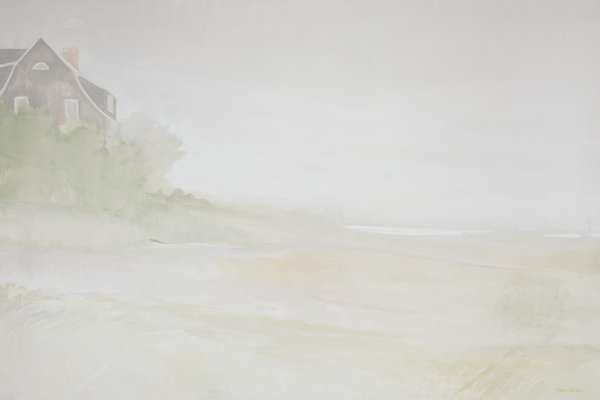
Curator Alicia Longwell surveyed the light-filled gallery inside the Parrish Art Museum, her hands delicately folded.
“There is no one better to observe a painting with than another painter,” she mused, contemplating the whitewashed walls dancing with colorful canvases by those she calls “The Janes.” “You always see things you’ve never seen, or thought of.”
The revelation came after a brief chat with North Haven-based artist April Gornik, who stopped by the Water Mill museum last Friday for a return visit to “Seen and Unseen: Jane Freilicher and Jane Wilson,” which opened last month.
“I think this is a great show and it’s wonderful to compare. There’s lots and lots of overlap, but specifically, they’re absolutely different,” Ms. Gornik said of the two artists on view, who were not only contemporaries, but good friends on the East End. “Jane Freilicher’s sense of detail is so important in the painting. She has a very deliberate hierarchy in the way that she does things. So the abstraction, when you come to it, is really surprising.
“And the Jane Wilsons are eventually headed into that really almost Rothko-ish kind of atmospheric abstraction,” she continued. “And I think they’re all completely valid, just looking at the intelligence of the choices in both their work, about when to be more abstract, when to be more detailed.”
Despite their close relationship, the women did not impact one another’s work, or even compete, according to Wilson. It was more about camaraderie in a male-dominated art scene.
“We spent time together in the same house for a few summers,” Wilson once said. “There was some sort of affinity in our painting, but it wasn’t actually that we influenced each other. Maybe a certain reinforcement.”
The women—who were both born in 1924 and died within a month of each other this past winter at age 90—first crossed paths in Manhattan, as they hailed from dramatically different backgrounds. Wilson was raised on an Iowa farm, where she undoubtedly developed an innate sense for weather and natural sensations, Ms. Longwell said, which are overwhelmingly present in her work. She earned a master’s degree from the University of Iowa, where she learned under abstract expressionist Philip Guston before heading to New York in 1949.
Meanwhile, Brooklyn-born-and-bred Freilicher had studied painting with Hans Hofmann in Provincetown and New York before receiving a master’s degree from Teachers College, Columbia University. Her first solo exhibition in 1952 was at the uptown Tibor de Nagy Gallery, and Wilson got her feet wet one year later at Tanager Gallery, an artists’ cooperative on East 10th Street.
“It was a very active scene, so I’m sure they were looking at art in both places,” Ms. Longwell said. “Freilicher married Joe Hazan in 1957 and they decided to rent a house on Flying Point Road, an old farmhouse. It was pretty big and spacious, and as young couples still do, they thought, ‘Why don’t we invite someone to share it with us.’ They asked Jane Wilson and her husband, John Gruen, that summer.”
The two couples entered what was already an extremely vibrant artists colony on the East End, soon settling down in houses of their own just a mile apart in Water Mill. They entertained the likes of artists Robert Rauschenberg and Jasper Johns, composer Leonard Bernstein, and poets Kenneth Koch, John Ashbery and Frank O’Hara.
And Wilson and Freilicher were holding their own.
“There was more than Jackson Pollock in 1956. He was the most famous painter in America, but there were all these other stories, too,” Ms. Longwell said.
The current Parrish retrospective, which features landscapes, still-life and portraits by Wilson and Freilicher, is divided among three galleries, sprinkled with early watercolors, charcoals and photographs along the museum’s spine.
The scope of the work spans from a 1952 Freilicher to a 2010 Wilson, according to Ms. Longwell. While both artists painted abstractly, Freilicher spoke of her need of “the seen”—her observations and subsequent details. Wilson, on the other hand, resonated with feeling, emotion and atmosphere, much of what cannot be seen. While many of Freilicher’s paintings depict specific scenes, Wilson’s are without edges. They could travel infinitely in any direction.
“We thought it was a really appropriate time, and moment, to do this,” Ms. Longwell said of the exhibition. “Looking at the two artists at once, there are so many things similar and so many things distinct. They are so divergent in the way they painted …”
A museum visitor interrupted the curator mid-thought.
“I just want to tell you I love the show,” she gushed. “It’s wonderful. They’re tremendous together, right here, in this museum. So, thank you.”
The curator nodded with appreciation. But it was not inward. Instead, it was toward the gallery walls, as if to give credit where it was due.
“Seen and Unseen: Jane Freilicher and Jane Wilson” will remain on view through January 18 at the Parrish Art Museum in Water Mill. “Circles of Friendship: Freilicher and Wilson,” a multimedia program featuring film screenings, a discussion and book signing, will be held on Saturday, November 7, at 11 a.m. Alicia Longwell will discuss the exhibition on Thursday, November 12, at noon, as part of the Brain Food series. Tickets for all are $10, or free for members. For more information, call (631) 283-2118, or visit parrishart.org.